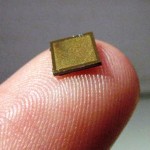 The nanopatch is a micro-needle patch comprising of little, densely packed micro-projections with a defined geometry.
The nanopatch is a micro-needle patch comprising of little, densely packed micro-projections with a defined geometry.
Drug delivery technologies that improve access and overall efficacy are becoming an essential part of the entire drug development process, with pharmaceutical companies investing billions of dollars in new vaccine delivery technologies in a bid to move away from needles and syringes to skin delivery procedures, according to a Frost & Sullivan report.
The report found that though the needle-free delivery sector currently makes up a small fraction of the total drug delivery market, the next five to 10 years will see transdermal and intradermal systems (patches and degradable implants), fast-dissolving tablet vaccines, inhalers, and pulmonary delivery methods change the vaccine industry.
The nanopatch is a micro-needle patch comprising of little, densely packed micro-projections with a defined geometry.
Smaller than a postage stamp–and getting smaller–nanopatches are capable of directly depositing vaccine to thousands of skin immune cells without causing damage to the cell membrane in the process.
The nanopatch also eliminates the need for refrigeration as the thermostable vaccine is formulated in dry form, making transportation significantly cheaper than traditional needles.
The development of thermostable vaccines with a long shelf life is specific area of focus for many vaccine manufacturers, especially for those marketing to nations where cold-chain storage is an issue, the report noted.
Sowmya Rajagopalan, research manager for advanced medical technologies with Frost & Sullivan, told eWEEK this type of technology would be beneficial globally, but most importantly in emerging markets, where the potential for vaccines is highest.
Although Rajagopalan believes this technology will likely be entering the marketplace in the near-term future, the firm is still unable to more specifically project a year for commercialization.
Significant advancements have been made, however, most of which have centered on addressing patient comfort levels and increasing the adoption of self-injectable therapies.
“It is not about pricing of the product, but the efficiency it can support. It can avoid needle stick injuries that occur in millions worldwide,” Rajagopalan said. “These deaths that can be avoided and other related costs incurred with hospital stays, could be decreased which in turn would support decreasing healthcare expenditure. Hence it’s not about product pricing but the cost efficiency it can provide, which makes this technology beneficial.”
With successful testing in animals, clinical trials on humans will need to be wrapped up to attain Food and Drug Administration approval.
Once this happens, the technology will rapidly gain traction both among patients and physicians, ultimately changing the course of vaccine delivery globally, the report projected.
Swathi Allada, a health care research analyst at Frost & Sullivan, noted early stage tests conducted on mouse models have shown that the nanopatch-delivered flu vaccine is effective even with 1/150th of the dose normally given through a traditional syringe.
Source: eWeek.com

















